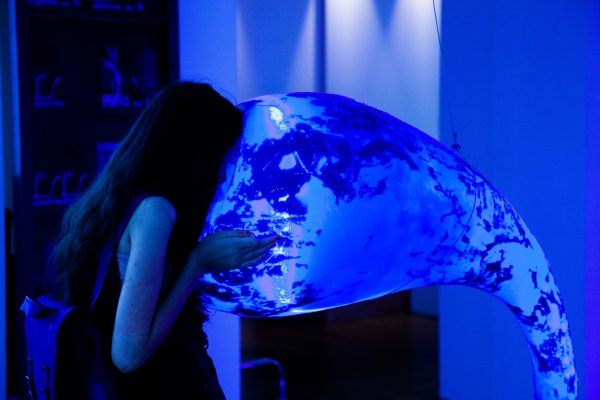I, Human

We are now engaged in a grand scheme to augment, amplify, enhance and extend the relationships and communications between all beings and all objects. [Kevin Kelly]
I, HUMAN creates an all-encompassing sensory environment of mutually programmed harmony generated in the tension of love and power between man, nature and machine.
I, HUMAN is an installation - a body - made of a virtual core and physical sculptures that snake
through the space like tentacles and are equipped with camera and sensors at their head or helmet-like ends.
I, HUMAN asks visitors to be fed emotions: Once engaged in communication, they analyse the emotional status of the users as well as the emotional cohesion of the group. Each head creates its own soundscape that induces different antagonistic psychological states. Users must disregard their personal context in order to synchronise emotionally. I, HUMAN is linked to a biophotonic experiment in the basement of the Centre for Advanced Laser Technologies in Bucharest. The degree of emotional cohesion controls the frequency and intensity of a laser that energises a population of eye animals. While acting as living test subjects, the users are also real-time observers of the experiment.
The installation uses deep-learning algorithms and bio-photonics to explore topics such as swarm intelligence, tests new models of behavioural ecology and illustrates the impact of technology on human behaviour.
I, HUMAN uses empathy to influence the nutrition/energy supply of microorganisms. Developed around the idea of interconnectivity, it analyses how individual interactions can generate collective outcomes at multiple levels by testing new models of technologically mediated synergistic behaviour and identifying patterns of coherence.
I, HUMAN is a metaphor for our evolution as a species, which might depend on our capacity for empathy.
Carmen Casiuc, on “Insatiable Machines” is a solo show of artist Saint Machine:
Saint Machine’s work is an artistic investigation into how humans, living organisms and machines control and communicate with each other through a complex dynamics of grace and greed. Working with programmers, physicists, engineers, 3d animators and sound artists, Saint Machine develops sophisticated systems to realize ambitious productions in which the experience of the public becomes an integral part of the artwork. Turning to design, cyberculture and speculative fiction as aesthetic templates, she creates high-tech phygital environments that refer to Christian thought and ritualistic behavior while presenting an animist vision of a technological future.
Melding Eastern and Western forms and mixing transcendental themes with open appeal to embodied experiences, the artist proposes a cultural condition in which aesthetics, spirituality and technology intermingle.
“I, Human” is one of Saint Machine’s large scale body installations that are organisms with a virtual core assimilating the public into their system through a carefully designed communication network of diverse media such as 3D imaging, resin and fibreglass sculptures, sound and bioart that is dependent of each user’s sensorial and psychological data. As in a religious experience, the phygital works demand belief and unconditional love in exchange of access into a sacred cyberspace in which both human and non-human life is improved and protected. The synergetic relationship developed in this fashion alters the conscious state of the public, invoking transcendental experiences which question the boundaries of personhood and the individuality of expression.
Revealing a renewed sensibility towards new technologies and a critical view of their ubiquitous adoption in today’s society, “I, Human” by Saint Machine generates an all-encompassing sensing environment of mutually programming harmony that reflects upon the modeling of collective affects produced within the holy tension of love and power between human, machines and nature.
"The survival of human species will depend on our capacity to understand that we are "the others". [Saint Machine]
